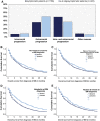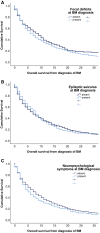Neurological symptom burden impacts survival prognosis in patients with newly diagnosed non-small cell lung cancer brain metastases
- PMID: 32678971
- PMCID: PMC7540353
- DOI: 10.1002/cncr.33085
Neurological symptom burden impacts survival prognosis in patients with newly diagnosed non-small cell lung cancer brain metastases
Abstract
Background: Brain metastases (BM) are a frequent complication of advanced cancer and are characterized by a variety of neurological symptoms. Although the presence of neurological symptoms is included in the response assessment in patients with primary brain tumors, to the authors' knowledge little is known regarding the prognostic impact of neurological symptoms in patients with BM.
Methods: Patients with newly diagnosed BM from non-small cell lung cancer were identified from the Vienna Brain Metastasis Registry and were evaluated according to the incidence, distribution, and prognostic impact of neurological symptoms at the time of diagnosis of BM.
Results: A total of 1608 patients (57.3% male and 42.7% female; median age, 62 years) were available for further analyses. Neurological symptoms including focal deficits (985 patients; 61.3%), signs of increased intracranial pressure (483 patients; 30.0%), epileptic seizures (224 patients; 13.9%), and neuropsychological symptoms (233 patients; 14.5%) were documented in 1186 of the 1608 patients (73.8%). Patients with asymptomatic BM presented with a longer median overall survival after the diagnosis of BM compared with patients with symptomatic BM (11 months vs 7 months; P < .001). In multivariate analysis with a diagnosis-specific graded prognostic assessment (hazard ratio, 1.41; 95% CI, 1.33-1.50 [P < .001]), the presence of neurological symptoms (hazard ratio, 1.39; 95% CI, 1.23-1.57 [P < .001]) was found to be independently associated with survival prognosis from the time of diagnosis of BM.
Conclusions: Neurological symptoms at the time of BM diagnosis demonstrated a strong and independent association with survival prognosis. The results of the current study have highlighted the need for the integration of the presence of neurological symptoms into the prognostic assessment of patients with BM from non-small cell lung cancer.
Lay summary: Neurological symptom evaluation is included regularly in the assessment of patients with primary brain tumors. However, to the authors' knowledge, little is known regarding the prognostic impact in patients with newly diagnosed brain metastases (BM). The current study has provided a detailed clinical characterization of the incidence, distribution, and prognostic impact of neurological symptoms in a large, real-life cohort of patients with BM from non-small cell lung cancer. In this cohort, neurological symptoms at the time of diagnosis of BM demonstrated a strong, independent prognostic impact on the survival prognosis. The results of the current study have highlighted the need for the integration of neurological symptom burden into the prognostic assessment of patients with BM from non-small cell lung cancer.
Keywords: neurological assessment; neurological symptoms; prognostic factors in brain metastases; survival prognosis in symptomatic brain metastases; symptomatic burden.
© 2020 The Authors. Cancer published by Wiley Periodicals LLC on behalf of American Cancer Society.
Conflict of interest statement
Matthias Preusser has received honoraria for lectures, consultation, or advisory board participation (all <€5000) from Bayer, Bristol‐Myers Squibb, Novartis, Gerson Lehrman Group (GLG), CMC Contrast, GlaxoSmithKline, Mundipharma, Roche, BMJ Journals, MedMedia, AstraZeneca, AbbVie, Lilly, Medahead, Daiichi Sankyo, Sanofi, Merck Sharp & Dohme, and Tocagen and has received research support from Bohringer‐Ingelheim, Bristol‐Myers Squibb, Roche, Daiichi Sankyo, Merck Sharp & Dohme, NovoCure, GlaxoSmithKline, and AbbVie for work performed outside of the current study. Anna Sophie Berghoff has received grants and personal fees from Daiichi Sankyo; honoraria for lectures, consultation, or advisory board participation from Roche, Bristol‐Myers Squibb, and Merck; and nonfinancial support from Roche, Amgen, and AbbVie for work performed as part of the current study and grants from Daiichi Sankyo and personal fees from Roche and Bristol‐Myers Squibb for work performed outside of the current study. The other authors made no disclosures.
Figures



References
-
- Jena A, Taneja S, Talwar V, Sharma JB. Magnetic resonance (MR) patterns of brain metastasis in lung cancer patients: correlation of imaging findings with symptom. J Thorac Oncol. 2008;3:140‐144. doi:10.1097/JTO.0b013e318161d775 - DOI - PubMed
-
- Brennum J, Kosteljanetz M, Roed HM. Brain metastases [in Danish]. Ugeskr Laeger. 2002;164:3522‐3526. - PubMed
Publication types
MeSH terms
Grants and funding
LinkOut - more resources
Full Text Sources
Medical

